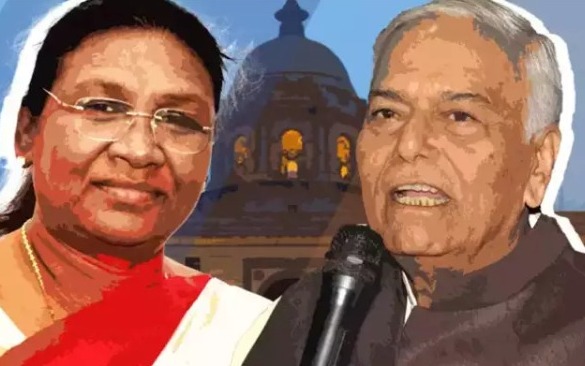
Voting for the presidential election in which NDA candidate Droupadi Murmu is pitted against joint opposition pick Yashwant Sinha began on Monday. Polling began at 10 am and Prime Minister Narendra Modi was among the first to cast his vote. The voting process would conclude at 5 pm.
Nearly 4,800 elected MPs and MLAs are entitled to vote in the election, but nominated MPs and MLAs, and members of Legislative Councils are not. Besides Room number 63 on the first floor of Parliament House, which has been converted into a polling station, voting is simultaneously taking place at various state assemblies.
In the national capital, voting is also underway at the Delhi legislative assembly. The counting of votes will be held on July 21. The system of secret ballots is followed in the presidential election, and parties cannot issue whips to their MPs and MLAs with regard to voting.
The value of the vote of a Member of Parliament has gone down to 700 from 708 in this presidential poll due to the absence of a legislative assembly in Jammu and Kashmir.
The value of the vote of an MLA varies in different states. In Uttar Pradesh, the value of the vote of each MLA stands at 208, followed by 176 in Jharkhand and Tamil Nadu. In Maharashtra, it is 175. In Sikkim, the value of vote per MLA is seven, while it is nine in Nagaland and eight in Mizoram.
In accordance with the system of proportional representation by means of a single transferable vote, every elector can mark as many preferences, as there are candidates contesting the election. These preferences for the candidates are to be marked by the elector, by placing the figures 1,2,3, 4, 5, and so on, against the names of the candidates, in the order of preference, in the space provided in column 2 of the ballot paper.
According to Election Commission’s directions, while MPs will get a green-colored ballot paper, the MLAs will get a pink ballot paper to cast their vote.
Droupadi Murmu
Murmu has previously served as the Jharkhand Governor for six years. She was sworn in as the Governor of the state on May 18, 2015, and served it for 6 years and 48 days. However, in July 2021 she left for her native city Rairangpur (Odisha) after completing her term as the Governor of Jharkhand.
Exactly a year later, the ruling NDA alliance nominated her for the country’s highest constitutional post.
Born on June 20, 1958, in Odisha to a simple Santhal tribal family, she started her political career in 1997 being elected as the Councillor of the district board in Rairangpur, Odisha.
Prior to joining politics, she had worked as an honorary assistant teacher at Sri Aurobindo Integral Education and Research, Rairangpur, and as a junior assistant in Odisha Irrigation Department before joining politics.
Murmu was elected twice as an MLA in Odisha and also got a chance to work as a Minister in the Naveen Patnaik government when the BJD-BJP coalition government was in power.
She was also awarded the Neelkanth Award for being the best legislator by the Odisha Legislative Assembly.
Yashwant Sinha
Yashwant Sinha started his political career in 1984 after taking voluntary retirement as an IAS officer.
He was fielded as a Janata Party candidate from the Hazaribagh parliamentary constituency in the 1984 Lok Sabha elections but faced a huge electoral defeat. Later in 1988, he was elected to the Rajya Sabha and served as the Union Finance Minister during the Chandrashekhar-led government at the Centre.
In 1995, he joined the Bharatiya Janata Party and was fielded as the party candidate from the Ranchi Assembly constituency. Thereafter, he became a member of the Bihar Assembly. Later, Sinha was also elected as the Leader of Opposition in the Bihar Assembly.
However, only after a year and a half, did the BJP decide to nominate him to the Upper House of Parliament. Later, he was elected to the Lok Sabha from the Hazaribagh constituency in 1998, 1999, and 2009. He also served as a Cabinet Minister during the then Vajpayee government at the Centre.— IANS